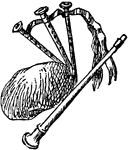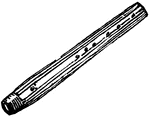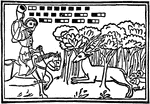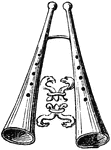Woodwind Musical Instruments
The Woodwind Musical Instruments ClipArt gallery offers 54 illustrations of the bagpipe, basset horn, bassoon, clarinet, contrabassoon, English horn, flute, oboe, saxophone and other woodwinds.

Bagpipe
A music wind instrument consisting of a leathern bag, which receives air from the mouth or from the…
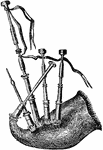
Bagpipe
The bagpipe is a wind instrument used among the ancient Greeks but is known as a Scottish and Irish…

Highland Bagpipe
Often present a gamut which appears to us grotesque, without subdominate, or incomplete, manfestly vestige…

Highland Bagpipe
"Bagpipe, a musical wind-instrument of very great antiquity, having been used among the ancient Greeks,…
Basset Horn
"A wood-wind instrument, not a "horn," member of the clarinet family, of which it is the tenor. The…

Chalil
A chalil, which is a pipe or flute. The word means "bored through" and is found in 1 Sam 10:5.
Clarinet
The richest instrument in compass and in variety of timbre of all the wind instruments. Its tube is…
Clarinet
A musical wind instrument consisting of a mouthpiece containing a single beating reed, a cylindrical…
Clarinet (Albert Model)
An illustration of an Albert model clarinet. The Albert system refers to a system of clarinet keywork…
Clarinet (Boehm Model)
An illustration of an Boehm model clarinet. The Böhm system for the clarinet is a system of clarinet…

Contrabassoon
The contrabassoon is a larger version of the bassoon sounding an octave lower. Its technique is similar…

French Contrabassoon
An illustration of the front (right) and back (left) of the French contrabassoon.
Cor Anglais
This is the same instrument as the oboe but a fifth below. Its tone is essentially sad, melancholy,…
Oboe D'amore
Intermediate between the oboe and the cor anglais, the oboe d'amore, an instrument now fallen into neglect,…
English Horn
The cor anglais, or English horn, is a double reed woodwind musical instrument in the oboe family.It…
English Horn
An illustration of an 18th century English Horn. The cor anglais, or English horn, is a double reed…
Flageolet
"A musical instrument of the flute or whistle class, in which the tone is produced by a stream of air…
Flute
Bore open and cylindrical, the only in which the vibratory motion is produced from a lateral mouth-hole.…
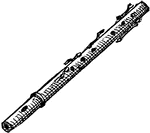
Flute
A cylindrical wind instrument, with holes along its length, stopped by the figners or by keys opened…

Flute
"In music, an instrument of the pipe kind, in which the tone is produced by the impact of a current…
Basset Horn
A tenor clarinet, pitched in F, having a wider bell and greater range than a standard clarinet.

The Lesson on the Flute
This painting, by Tistian is a great example of his oil on canvas technique. It can now be found hanging…
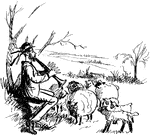
Man Playing Clarinet
An illustration of a man playing a clarinet while sitting with sheep at his feet.

Clarinet Mouthpiece with Reed
An illustration of a clarinet mouthpiece and reed. The reed (b) is placed into the whole in the mouthpiece.…
Oboe
Conical tube, in which the column of air is made to vibrate by means of a double reed, that is to say,…
!["A pipe of this nature fitted with a piece of glass so as to exhibit the reed (which is a "free reed") is shown in [the illustration]. Q is the wind-chest of the bellows, into which P is fitted. In the right-hand figure the upper part of the pope is removed, so as to show the reed more clearly. A plate of metal c c, has a slit but in it, in which the tongue I may just past. By means of a curved wire, r, projecting above the top of the pipe, and the play of the tongue may be controlled and the pipe tuned. The conical pipe, H, placed at the top, serves to increase the power of the sound". -Benson, 1891](https://etc.usf.edu/clipart/62100/62146/62146_reed_mth.gif)
Reed
"A pipe of this nature fitted with a piece of glass so as to exhibit the reed (which is a "free reed")…
Bagpipe Reed
"The Reed is the sounding part of several instruments, such as the clarionet, bassoon, oboe, and bagpipe,…
Bagpipe Reed
"The Reed is the sounding part of several instruments, such as the clarionet, bassoon, oboe, and bagpipe,…
Bagpipe Reed
"The Reed is the sounding part of several instruments, such as the clarionet, bassoon, oboe, and bagpipe,…
Oboe Double Reed
An illustration of an oboe double reed. The cane is folded in half and shaped. The bottom is wrapped…

Saxophone
"The saxophone, a brass musical instrument invented by Adolphe Sax. It consists of a conical brass tube,…

Serpent
The serpent is "a musical instrument, properly of the trumpet family, having a cupped mouthpiece, a…
